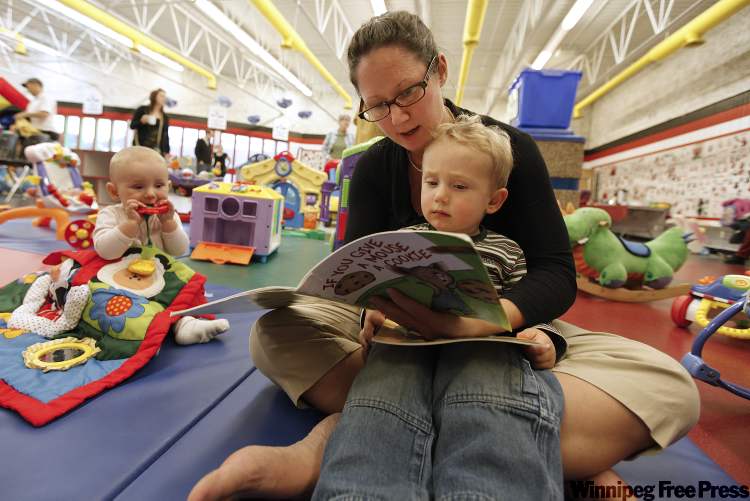Pols woo middle-class women
Parties playing to vote-rich sector in commercials
Advertisement
Read this article for free:
or
Already have an account? Log in here »
To continue reading, please subscribe:
Monthly Digital Subscription
$1 per week for 24 weeks*
- Enjoy unlimited reading on winnipegfreepress.com
- Read the E-Edition, our digital replica newspaper
- Access News Break, our award-winning app
- Play interactive puzzles
*Billed as $4.00 plus GST every four weeks. After 24 weeks, price increases to the regular rate of $19.00 plus GST every four weeks. Offer available to new and qualified returning subscribers only. Cancel any time.
Monthly Digital Subscription
$4.75/week*
- Enjoy unlimited reading on winnipegfreepress.com
- Read the E-Edition, our digital replica newspaper
- Access News Break, our award-winning app
- Play interactive puzzles
*Billed as $19 plus GST every four weeks. Cancel any time.
To continue reading, please subscribe:
Add Winnipeg Free Press access to your Brandon Sun subscription for only
$1 for the first 4 weeks*
*$1 will be added to your next bill. After your 4 weeks access is complete your rate will increase by $0.00 a X percent off the regular rate.
Read unlimited articles for free today:
or
Already have an account? Log in here »
Hey there, time traveller!
This article was published 20/09/2011 (5110 days ago), so information in it may no longer be current.
Bryanna Spina is a hot commodity.
Her vote, and the vote of women like her, is probably the most sought-after one this provincial election. But those seeking to woo Spina with expensive TV ads and carefully crafted health-care announcements might be chagrined to know the mother of three hasn’t really noticed. Neither have many in the gaggle of mothers at the Earl Grey Community Centre’s drop-in play program.
“I haven’t explored all the candidates, but when I do, it will be about what issues affect my family,” said Spina as she spooned pureed sweet potatoes off baby Ilia’s nose.

That means education, community resources, crime and the environment.
Spina always votes, as do most women, which is why they are often campaign targets. She’s spotted lawn signs and caught snippets about the election on her car radio, but she doesn’t have much time for TV and hasn’t followed the bevy of daily promises made by the province’s leaders. A few days before Oct. 4, she’ll likely hunker down, go online, review the candidates and the promises and make her choice.
With several family-friendly ridings up for grabs in south Winnipeg — Seine River, St. Norbert, River Heights — female voters are more important than ever.
“I would say it’s the war for the middle-class woman voter,” said Chris Adams, a political scientist and pollster with Probe Research.
The Tory advertising campaign has made a clear bid for female voters, pitching leader Hugh McFadyen as a family man with his wife and children playing a board game in the background. The party’s “I can’t vote NDP” commercial features almost all women — not low-income women, not farm women or First Nations women, but middle-class ones, Adams noted.
The Liberals, too, have launched a cheeky ad featuring a woman and her daughter looking on with contempt while two obnoxious schoolboys in suits — McFadyen and Selinger — bicker and swat at each other.
Premier Greg Selinger touts his female MLAs and candidates almost as often as he touts the return of the Jets. At a health announcement last week, in a not-so-subliminal shout-out to women, Selinger made a health promise surrounded by nearly every female NDP politician in south Winnipeg, framed perfectly for television news clips.
According to Probe Research’s last poll, done in early summer, the NDP still leads among female voters in Winnipeg, but the lead had narrowed a fraction since the 2007 election.
Among women, 51 per cent favoured the NDP and 35 per cent decided to vote Tory. In the last election, the figures were 53 per cent to 27 per cent. How women are leaning now, as the campaign matures, won’t be known until the next Free Press/Probe poll is released closer to voting day.
Sherry Schellenberg, a public health nurse with two small children, might be a tough sell.
As her husband played with the kids at Earl Grey, she told the Free Press she’s normally loyal to one party and hasn’t seen much that will change her mind.
A party’s core values, not a sprinkling of fleeting promises, are what matter most to her. Just like Spina, she somewhat sheepishly says she’s been too busy to immerse herself in the daily doings of the campaign beyond keeping track of her candidates’ names.
“I haven’t really noticed,” said the River Heights resident. “We’ve had a lot of phone calls from candidates and visits to our door, though.”
She joked that any TV she has time to watch is recorded on her family’s PVR, so she fast-forwards through the commercials.
Voter turnout among women is about three or four percentage points higher than among men, but according to new studies by Queen’s University political scientist Melanee Thomas, women tend to vote out of a sense of civic duty rather than an abiding interest in politics. And they tend to feel less knowledgeable about government and less effective in the political sphere.
Adams backs that up. In 2005, he ran the numbers from previous Probe polls and found that 26 per cent of women compared with only 18 per cent of men were unable to identify a political preference. Adams termed those voters “disengaged.” They might still vote, but they weren’t plugged in enough to say which way they were leaning.
Research shows women also tend to lean a little to the left and are most interested in the so-called soft issues such as health care, the environment, education. Men care more about taxes, the economy and infrastructure.
Adams says the top two issues that appeal to middle-class women are health care and education, and savvy politicians from U.S. President Barack Obama to Saskatchewan Premier Bad Wall have used those issues to win over female voters.
Despite their television commercials, the Tories have strayed somewhat from health and education, hammering Selinger on crime, the province’s finances and the Bipole III power line.
The NDP might be winning the “women’s-issue” war. Its daily announcements have almost entirely focused on health care. One of the party’s very few non-health-related announcements came right off the hop, a pledge to cap kindergarten to Grade 3 class sizes to 20 students. That’s a classic mom vote-getter.
maryagnes.welch@freepress.mb.ca
60 women in ring this campaign
As a preliminary tally, there are 60 female candidates this year from the four major parties compared to 58 in 2007. That’s one per riding.
Political scientists say what really matters, however, is how many women are running in winnable ridings. Often parties pad their roster of female candidates by wooing them to run as no-hope contenders. Here’s how many women are running in 15 swing ridings:
Seine River 1
Riel 3
Kirkfield Park 3
River Heights 1
Assiniboine 2
St. James 1
Fort Richmond 2
St. Norbert 1
Swan River 0
Interlake 0
Dauphin 1
Dawson Trail 1
Southdale 2
St. Vital 1
Tyndall Park 0
— Source: Elections Manitoba official candidate list as of Sept. 18






